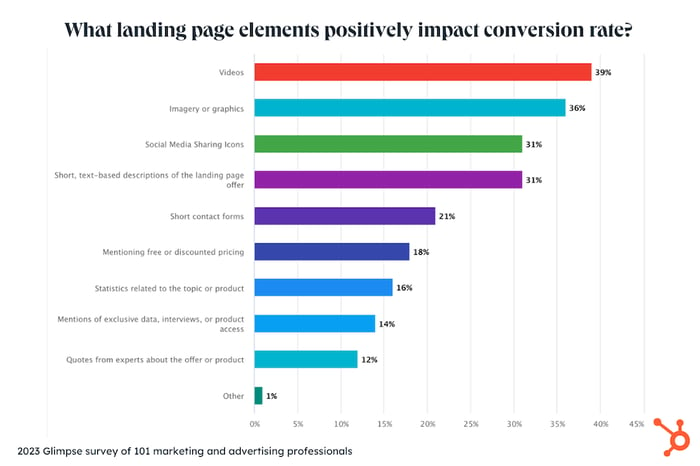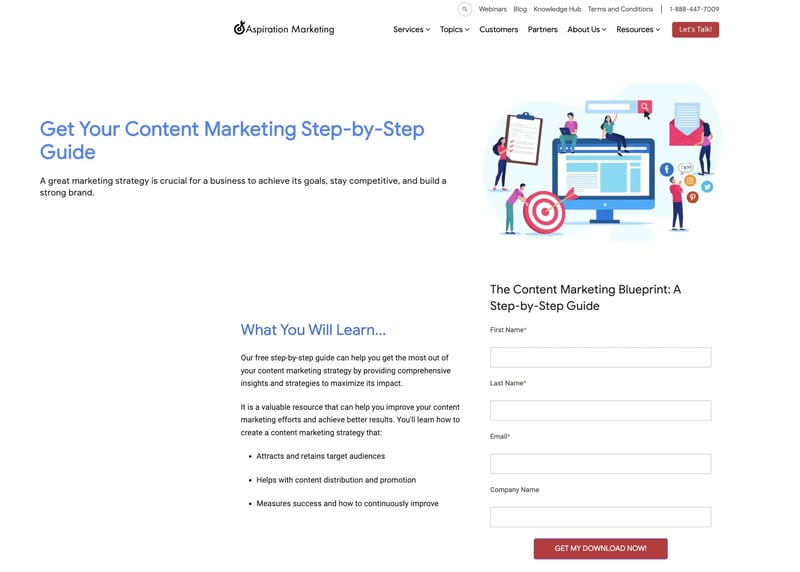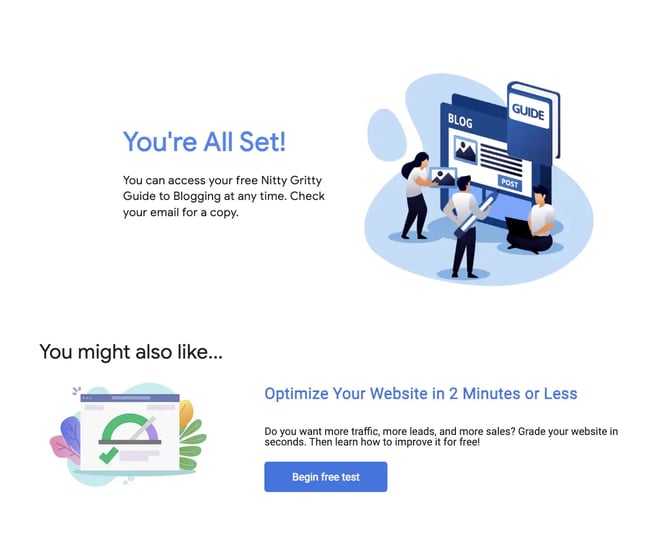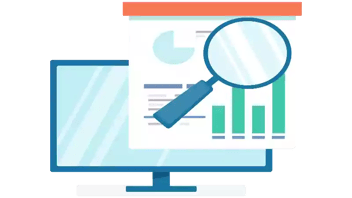Qual è lo scopo di una Landing Page? Migliori pratiche di marketing
Siete stanchi del traffico sul sito web che non si trasforma mai in vendite?
Le landing page potrebbero essere l'arma segreta che vi manca. Il vostro sito web non deve solo attirare traffico, ma anche generare un flusso costante di contatti. Le landing page possono essere la chiave per sbloccare questa crescita.
Scopriamo come funzionano le landing page e come crearne una che trasformi la vostra attività.

Perché le landing page sono importanti?
-
Le aziende vedono un enorme aumento dei contatti con un maggior numero di landing page. Le aziende con 31-40 landing page generano un numero di contatti 7 volte superiore rispetto a quelle con solo 1-5 landing page. E i numeri sono ancora più impressionanti: le aziende con più di 40 landing page hanno generato un numero di lead 12 volte superiore a quelle con solo 1-5 landing page. [HubSpot]
-
Più di un leader di marketing su tre cita i tassi di conversione come uno dei principali KPI a cui dà priorità il monitoraggio [HubSpot].
-
Il tasso di conversione medio di una landing page è del 26%. Il67% di tutti i marketer raggiunge un tasso di conversione superiore al 10% per le proprie landing page. Meno del 10% raggiunge livelli di conversione superiori al 70%. [Selezione dei fornitori di e-mail].
-
I tempi di caricamento rapidi sono essenziali per mantenere l'attenzione. Un ritardo di appena 1 secondo nel tempo di caricamento della pagina può portare a una riduzione del 7% delle conversioni [Think with Google].

Cosa sono le landing page?
Una landing page è uno strumento di focalizzazione progettato per uno specifico scopo di marketing. In sostanza, si tratta di una pagina web indipendente creata per guidare i visitatori verso un'azione particolare. Ciò che distingue una landing page è la sua semplicità e immediatezza, riducendo al minimo le distrazioni per mantenere gli utenti concentrati su un unico obiettivo. È tutta una questione di ottimizzazione del tasso di conversione.
Una landing page è un punto di ingresso dedicato, che indirizza i visitatori da varie fonti come i social media, le campagne e-mail, i risultati dei motori di ricerca o le Call-to-Action (CTA) di un sito web. Le caratteristiche principali differenziano una landing page dalle altre pagine del sito web. In particolare, manca di menu di navigazione estesi e di link esterni, mantenendo un design semplice per mantenere l'attenzione dell'utente sulla call to action principale. Le landing page sono inoltre personalizzate in base alla fonte di traffico che le indirizza, garantendo un'esperienza utente coerente e omogenea.
Una landing page è uno strumento specializzato che cattura l'attenzione, mantiene il focus e spinge l'utente a compiere azioni specifiche. Il suo ruolo ben definito la rende una risorsa essenziale per qualsiasi campagna di marketing digitale di successo.
A cosa serve una landing page?
Al centro di ogni landing page ben realizzata c'è il suo scopo principale: un obiettivo unico che ne definisce l'esistenza nel panorama del marketing digitale. L'obiettivo fondamentale di una landing page è quello di favorire le conversioni. Che si tratti di incoraggiare i visitatori all'acquisto, alla compilazione di un modulo o all'iscrizione a una newsletter, lo scopo principale di una landing page è quello di guidare gli utenti senza soluzione di continuità verso un'azione specifica e predefinita.
A differenza delle pagine web più ampie, che possono avere uno scopo informativo o di navigazione, le landing page sono progettate strategicamente per essere incentrate sulla conversione. Agiscono come porte d'ingresso virtuali, accompagnando i potenziali clienti attraverso l'imbuto del marketing con precisione e intenzione.
L'attenzione primaria alla conversione è ciò che contraddistingue le landing page. Queste pagine semplificano il percorso dell'utente eliminando le distrazioni inutili e presentando una CTA, riducendo al minimo l'attrito tra interesse e azione. Questa semplicità intenzionale riduce il carico cognitivo e guida gli utenti verso il risultato desiderato.
Ecco un esempio di una delle nostre CTA. Facendo clic su questo pulsante, i visitatori del sito web vengono automaticamente portati alla pagina di destinazione associata (mostrata qui sotto) e invitati a compilare un modulo per ottenere il download.

Lo scopo principale di una landing page è inseparabile dagli obiettivi di marketing più ampi. Indipendentemente dal tipo di landing page, che sia parte di un lancio di prodotto, di una campagna di lead generation o di uno sforzo promozionale, le landing page sono finemente sintonizzate per allinearsi e amplificare gli obiettivi di marketing generali. Questo allineamento strategico garantisce che ogni aspetto della pagina, dal design alla messaggistica, funzioni armoniosamente per raggiungere i risultati previsti.
L'efficacia di una landing page viene spesso misurata in base al suo tasso di conversione, ovvero la percentuale di visitatori che completano l'azione desiderata. Questa metrica fornisce indicazioni preziose sulle prestazioni della pagina ed è un indicatore cruciale del suo successo nel raggiungere lo scopo principale. Il monitoraggio, l'analisi e l'ottimizzazione continui sono essenziali per garantire che la landing page si evolva in base alle dinamiche di marketing e ai comportamenti dei consumatori.
Funzioni chiave
1. Catalizzatore di conversioni
La funzione principale di una landing page è quella di fungere da catalizzatore di conversione. A differenza delle pagine web generiche, una landing page è meticolosamente realizzata per guidare i visitatori verso un'azione specifica, che sia l'acquisto, l'iscrizione a un servizio o il download di contenuti. La natura focalizzata delle landing page riduce al minimo le distrazioni, guidando gli utenti direttamente verso l'obiettivo di conversione desiderato.
-
Viaggio dell'utente semplificato: Le landing page semplificano il percorso eliminando gli elementi non necessari che potrebbero distogliere l'attenzione. Una landing page ben ottimizzata presenta una proposta di valore chiara e una CTA convincente, riducendo l'attrito tra l'interesse dell'utente e la conversione finale.
-
Moduli ottimizzati: Per la generazione di lead, le landing page presentano spesso dei moduli. Questi moduli sono progettati con cura per raccogliere le informazioni essenziali senza sovraccaricare il visitatore. L'ottimizzazione della lunghezza e della chiarezza dei moduli aumenta le probabilità di successo delle conversioni.
2. Generazione di lead
Le landing page sono fondamentali per la generazione di lead, in quanto sono centri dedicati alla cattura di informazioni preziose sui clienti. Offrendo in cambio qualcosa di valore, come un whitepaper, un webinar o un accesso esclusivo, le landing page invogliano i visitatori a fornire i loro dati, ampliando il bacino potenziale di lead per le future attività di marketing.
-
Offerte incentivate: Una lead generation efficace si basa su offerte incentivate. Le landing page comunicano in modo conciso il valore dell'offerta, incoraggiando i visitatori a scambiare i loro dati di contatto con il contenuto o il servizio promesso.
-
Posizionamento strategico dei moduli: Il posizionamento strategico dei moduli di acquisizione di lead nelle landing page è fondamentale. Che sia sopra la piega o dopo una descrizione convincente del prodotto, il posizionamento dei moduli influisce sui tassi di conversione. È fondamentale trovare un equilibrio tra visibilità ed esperienza dell'utente.
3. Approfondimenti sui dati
Le landing page sono fonti di dati e approfondimenti inestimabili, in quanto offrono agli addetti al marketing una comprensione sfumata del comportamento, delle preferenze e dei livelli di coinvolgimento degli utenti.
-
Integrazione delle analisi: I marketer possono accedere a una grande quantità di informazioni integrando gli strumenti di analisi. Metriche come la frequenza di rimbalzo, il tempo trascorso su una pagina e i tassi di conversione forniscono informazioni utili per prendere decisioni strategiche.
-
Opportunità di test A/B: Le landing page facilitano i test A/B, consentendo agli addetti al marketing di sperimentare elementi come titoli, immagini o CTA. L'analisi delle prestazioni delle variazioni aiuta a perfezionare e ottimizzare la pagina per ottenere il massimo impatto.
4. Creazione di fiducia e credibilità
Stabilire la fiducia è un aspetto critico del successo del marketing online. Le landing page contribuiscono a creare fiducia e credibilità in diversi modi.
-
Coerenza del marchio: Una landing page ben progettata riflette un branding coerente, rafforzando l'identità del marchio e favorendo la fiducia. La coerenza dei messaggi, delle immagini e degli elementi di design nei vari canali di marketing aumenta la credibilità.
-
Prove sociali e testimonianze: L'inclusione di prove sociali, come le testimonianze dei clienti o le recensioni degli utenti, nelle pagine di destinazione aggiunge autenticità e crea fiducia. Le esperienze reali di clienti soddisfatti infondono fiducia nei potenziali acquirenti.
5. Campagne specifiche di nurturing
Le landing page sono fatte su misura per supportare e amplificare specifiche campagne di marketing, garantendo un approccio coeso e mirato.
-
Allineamento alla campagna: Le landing page sono realizzate per allinearsi perfettamente al tema e al messaggio di una particolare campagna. Che si tratti del lancio di un prodotto, di una promozione stagionale o della registrazione di un evento, la landing page è un'estensione della campagna.
-
Messaggistica mirata: La natura focalizzata delle pagine di destinazione consente una messaggistica precisa. I responsabili del marketing possono adattare i contenuti alle esigenze e agli interessi specifici del pubblico target, aumentando la rilevanza e l'impatto della campagna.
Creare una landing page efficace
La creazione di una landing page comporta un delicato equilibrio tra design, copywriting ed esperienza utente. In questo capitolo esploreremo gli elementi chiave che contribuiscono alla creazione di una landing page efficace, che catturi il pubblico e lo spinga verso l'azione desiderata.
Design della landing page
L'aspetto visivo di una landing page è fondamentale. Un design pulito e ordinato migliora l'estetica e facilita l'esperienza dell'utente.
-
Gerarchia visiva: Stabilire una chiara gerarchia visiva guida i visitatori attraverso la pagina, dirigendo la loro attenzione verso elementi essenziali come il titolo, le immagini e la call-to-action. Questa gerarchia assicura che i visitatori assorbano le informazioni cruciali nell'ordine previsto.
-
Coerenza del marchio: Il mantenimento di elementi di branding coerenti, tra cui colori, caratteri e immagini, favorisce la fiducia e rafforza l'identità del marchio. Un design coeso infonde fiducia nei visitatori e rafforza la connessione tra la landing page e il vostro marchio in generale.
Copywriting
La creazione di un testo persuasivo e conciso è la chiave di volta di landing page efficaci. Il messaggio deve essere chiaro, convincente e direttamente allineato all'azione desiderata.
-
Proposta di valore chiara: Comunicare il valore della vostra offerta. I visitatori devono capire che cosa possono ottenere dall'impegno con la pagina di destinazione entro pochi secondi dall'arrivo.
-
Concisione: Mantenete il testo conciso e diretto. Evitate il gergo inutile o i dettagli eccessivi che potrebbero distrarre o sopraffare i visitatori. Ogni parola deve contribuire alla chiarezza complessiva del messaggio.
Chiamata all'azione (CTA)
La CTA è il perno di una landing page, che guida gli utenti verso l'obiettivo finale della conversione. Ottimizzare la CTA e stabilire le Best Practice per le Call To Action è essenziale per massimizzare l'efficacia della landing page.
-
Posizionamento strategico: Posizionare la CTA in modo prominente sulla pagina, assicurandosi che sia visibile senza un eccessivo scorrimento. Un posizionamento strategico aumenta la probabilità di interazione dell'utente.
-
Linguaggio convincente: Costruite la CTA con un linguaggio accattivante, che trasmetta urgenza o sottolinei i vantaggi di un'azione. Frasi come "Inizia subito" o "Sblocca il tuo accesso esclusivo" infondono un senso di immediatezza e valore.
"Pagina di ringraziamento
Al di là della landing page in sé, la fase successiva al coinvolgimento è altrettanto cruciale. L'implementazione di una pagina di ringraziamento dopo che i visitatori hanno completato l'azione desiderata, come la compilazione di un modulo o il download di un contenuto, aggiunge un valore significativo all'esperienza dell'utente.
-
Conferma e apprezzamento: Una pagina "Grazie" conferma che l'azione dell'utente è andata a buon fine. Trasmette l'apprezzamento per il suo impegno, creando un'interazione positiva che aumenta la soddisfazione dell'utente.
-
Prossimi passi e informazioni aggiuntive: Questa pagina aggiuntiva può anche fornire le fasi successive o ulteriori informazioni. Ad esempio, se l'utente si è iscritto a una newsletter, la pagina "Grazie" può includere dettagli su cosa aspettarsi nelle prossime newsletter o offrire link a contenuti correlati.
-
Incoraggiare un ulteriore coinvolgimento: La pagina "Grazie" è un'opportunità per incoraggiare un ulteriore coinvolgimento. Includere link ai social media, suggerimenti di contenuti correlati o inviti a esplorare altre parti del vostro sito web mantiene l'utente attivamente coinvolto con il vostro marchio.

Qui sopra un esempio di pagina di ringraziamento che appare dopo che il visitatore di un sito web ha completato un modulo e compiuto l'azione desiderata.
SEO delle pagine di atterraggio
L'ottimizzazione per i motori di ricerca (SEO) è la spina dorsale della visibilità online e quando si tratta di landing page, un approccio strategico è fondamentale per massimizzarne la portata.
-
Ricerca e integrazione delle parole chiave: Effettuare una ricerca approfondita sulle parole chiave e integrare strategicamente i termini rilevanti nel titolo, nel contenuto e nei meta tag della landing page per migliorare la visibilità.
-
Struttura ottimizzata: Garantire una struttura URL facile da usare, utilizzare i tag di intestazione per la gerarchia dei contenuti e impiegare una formattazione pulita sia per gli utenti che per i motori di ricerca.
-
Reattività e velocità per i dispositivi mobili: Date priorità alla reattività dei dispositivi mobili, ottimizzate i tempi di caricamento e sfruttate strumenti come le CDN per migliorare l'esperienza complessiva dell'utente e le prestazioni SEO.
La comprensione e l'implementazione di strategie efficaci per le landing page sono essenziali per il successo. Dopo aver letto questo blog, dovrebbe essere chiaro che questi punti di ingresso digitali non sono semplici segnaposto, ma strumenti dinamici che richiedono un'attenta considerazione. Da principi di design meticolosi e copywriting persuasivo all'integrazione SEO strategica e all'allineamento multicanale, ogni aspetto contribuisce all'efficacia complessiva di una landing page.
Questo contenuto è disponibile in:
- Tedesco: Was ist der Zweck einer Landing Page? Tipps für's Marketing
- Inglese: What is the Purpose of a Landing Page? Best Practices in Marketing
- Spagnolo: ¿Cuál es el objetivo de una landing page? Prácticas en marketing
- Francese: Bonnes pratiques et l'objectif d'une page d'atterrissage ?
- Rumeno: Landing Page: Scop și cele mai bune practici de marketing
- Cinese: 着陆页的目的是什么?最佳营销实践










Facci sapere cosa ne pensi.